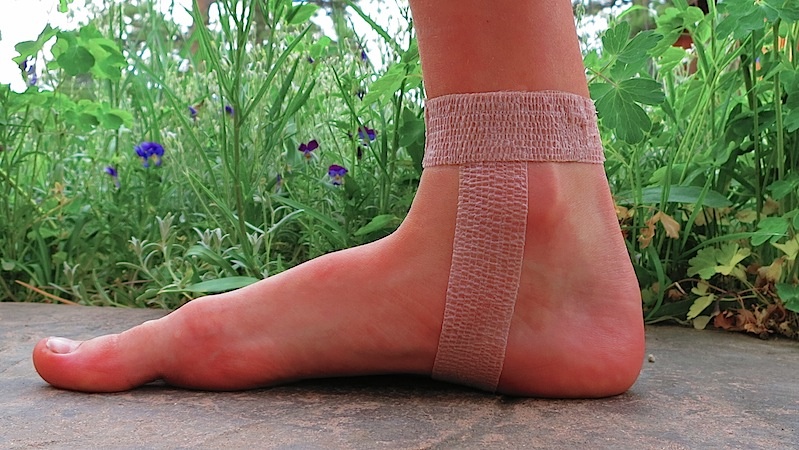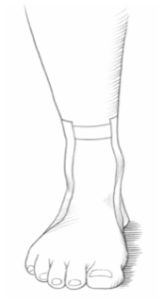
This simple self-health technique using two strips of tape can help improve foot function and heal muscles and joints.
Our image of using athletic tape is largely formed by what we’ve seen on TV during football games. A linebacker got hurt on the last play and rolls of tape are wrapped around and around the player’s ankle — thick and tight to prevent too much movement and protect the surrounding soft tissues and joints.
While this technique may have merit for football players in certain circumstances, it is not applicable to most injuries sustained by average athletes who run, bike, swim, walk or do aerobics classes or gym workouts.
There are many different taping methods used by a variety of therapists for a multitude of foot problems. In some cases, these are for emergency purposes, such as to provide temporary immobilization following an accident. In other cases tape may be used during an athletic event, or to provide support during the healing process.
However, problems associated with taping include weakening of muscles and ligaments.
Another type of taping I sometimes use is soft taping, which is much different from the other traditional taping techniques.
The intention of soft taping is not to support the foot or ankle, but to help heal an area of the body, such as a joint, muscle or other soft tissue, by stimulating the sensitive nerves in the area to improve foot-sense. It is a very light taping typically using just two pieces of tape.
Foot-sense is associated with the brain’s sensing of position and movement. The loss of foot-sense can lead to dysfunction and injury, while improving this awareness can restore normal foot function.
Soft taping can help improve muscle function in the lower limb to correct many types of chronic foot, ankle and leg problems. These include recurrent sprained ankles, plantar problems, heel problems, and many others including those annoying undiagnosed conditions.
This type of taping is accomplished with two simple steps. It requires one-inch white athletic tape available in most drug stores (though it doesn’t have to be white or called “athletic”). Slightly wider or thinner tape is acceptable. Both pieces should be about 12 inches, more for larger and less for smaller bodies. Here are the two steps:
 First, place one piece of tape around the lowest part of the leg, just above the two prominent bones on either side of the ankle. This piece should overlap itself by a couple of inches, fit snugly but not tight, and should stick to the leg.
First, place one piece of tape around the lowest part of the leg, just above the two prominent bones on either side of the ankle. This piece should overlap itself by a couple of inches, fit snugly but not tight, and should stick to the leg.- Second, attach another piece of tape onto the first, facing downward, and wrap it down the outside and under the mid-foot. Wrap it up the inside of the ankle at the middle of the arch, and attach it to the other side of the first piece. See figure below.
If the second piece of tape does not stick well to the first, apply a short, two-inch piece over the attachments to help it stick.
The goal is not to support the foot or ankle, so you should not feel the tape providing any supporting role, but you’ll feel it tugging on your skin. It should be comfortable, not tight. At the end of the day when you may have more fluid in your foot and ankle, it should not be tight or uncomfortable. For this reason, in some people, it’s best to first apply the tape in the early evening.
Leave the tape on for several days. It will gradually begin to peel off — if this occurs sooner, apply new tape. It should not be soaked in a bath, but can be wet from a shower and carefully dried. Remove it after a few days and leave it off for a week. If you are spending time barefoot, you should feel improvement in the function of your foot after the first application. If there is no improvement or only very small improvements, tape the foot and ankle again for the same period of time.
In some situations, taping may have to be done regularly. This may be the case if you’ve been wearing bad shoes, when you have to wear heavy or over-supported shoes for work, or any footwear that is not comfortable. It may also be necessary as part of an ongoing rehabilitation program for a more severe problem such as a stroke or spinal injury.








